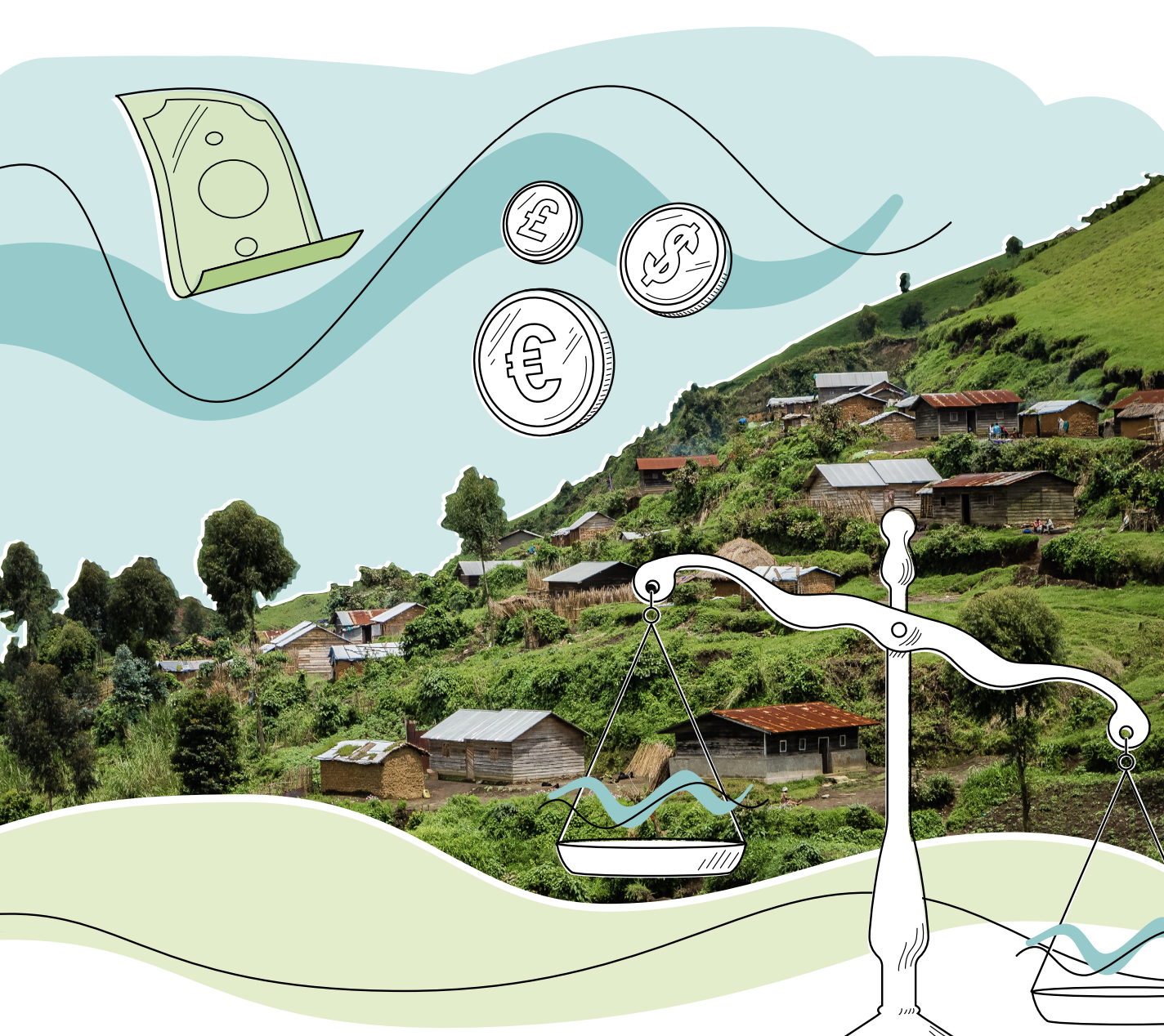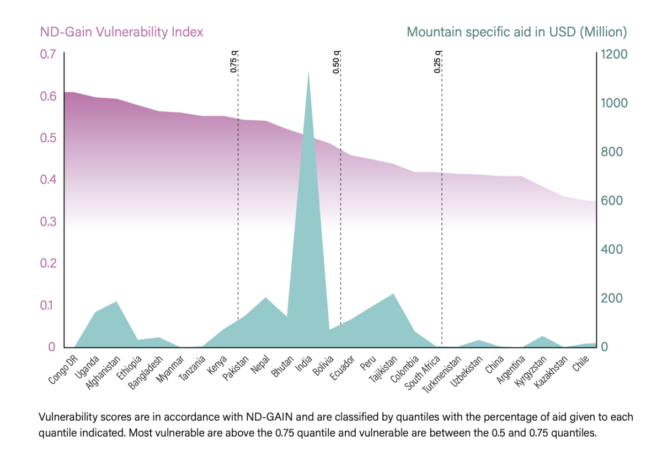Leave No Mountain Behind: The Synthesis Series: Is public funding of adaptation going to the mountain regions most in need?

Introduction
Mountains feature some of the clearest indications of climate change: rising temperatures, melting glaciers and changing precipitation patterns are disrupting water flows and affecting ecosystems, creating and worsening natural hazards and threatening livelihoods and communities both within the mountains and downstream. Understanding the geographic distribution and drivers of financial aid for climate change adaptation in sensitive socioecological environments such as mountains is therefore of paramount importance in optimising future programmes and enhancing sustainable development. A clear evidence base that supports donors in their allocation of funding has been lacking.
This article is an abridged version of the original text, which can be downloaded from the right-hand column. Please access the original text for more detail, research purposes, full references, or to quote text.
Method
Under the Adaptation@Altitude (A@A programme), a comprehensive screening of 7,560 adaptation projects was undertaken based on online international and bilateral donor databases. All funded projects were individually reviewed in order to identify whether the objectives or outcomes were conceived for adaptation in or for mountain regions.
In total, 444 mountain adaptation projects were identified (6 per cent of all adaptation projects) providing a unique basis with which to explore the funding sources and distribution of mountain adaptation financing in the form of Official Development Assistance (ODA). Projects financed in UNFCCC Annex 1 countries (e.g. in the European Alps and the North America region) were excluded.
For more than 100 of these 444 projects, further details relating to the implementation and achievements of the activities are showcased in detail at the A@A Solutions Portal.
Online reporting of financial information for projects prior to around 2011 is generally limited or inconsistent, while the onset of the global Covid-19 pandemic is expected to have introduced new priorities and challenges for donors. While not complete for all mountain countries, this analysis provides a unique stocktake of financial aid allocations in mountains, and explores recipient need and merit in aid allocation decisions.
Key Findings
This section outlines the key findings of the synthesis brief, based on the 444 projects identified in the comprehensive screening. The projects were funded by bilateral and multilateral donors, were implemented over the 2011–2019 period, and span 25 mountain countries. For much more detail please refer to the original publication.
- Over the 2011–2019 period, around 6 per cent of all bilaterally or multilaterally funded adaptation projects targeted mountain regions. Mountain adaptation projects over this period received, on average, around USD 6.7 million per project, compared to an average of USD 2.6 million per project for all adaptation projects globally.
- The vast majority of funding for adaptation projects in mountain regions comes from multilateral donors. There is a remarkable difference in the sources of funding for general adaptation projects compared to mountain-specific adaptation projects.
- Switzerland is a key contributor to bilateral funding of adaptation projects in mountain regions. The top five donor countries for the period analysed – Switzerland (USD 71.3 million), Germany (USD 70.0 million), Canada (USD 64.0 million), Australia (USD 36.0 million), and France (USD 27.0 million) – financed 78 per cent of the total bilateral mountain financial aid.
- Adaptation funding is unevenly distributed across mountain regions. The Hindu KushHimalaya region received by far the largest proportion of adaptation funding at 65 per cent (USD 1.798 billion), followed by the Andes with 15 per cent (USD 428 million), Central Asia with 11 per cent (USD 300 million) and finally Africa with 9 per cent (USD 250 million).
- Overall, India received the largest amount of funding for mountain adaptation projects, although Bhutan and Tajikistan rank higher in terms of adaptation funding per mountain population. India received a total of USD 1.1 billion between 2011 and 2019 for adaptation projects across its seven Himalayan states and union territories.
- Adaptation financial aid is tending to flow to vulnerable mountain countries, but not to the most vulnerable. A comparison against national-level vulnerability index scores extracted from ND-GAIN shows that the most vulnerable countries, such as The Democratic Republic of Congo, Ethiopia, Myanmar and Tanzania, have received little funding for mountain adaptation (17 per cent of the total).

- Donors appear to strike a balance between the readiness of the country to implement adaptation and its need for assistance. A country’s ability or readiness to leverage investments to implement adaptation projects can also play a role in funding allocations, and is influenced by such factors as social and economic stability, governance, and institutional capacities. While some scholars report that country merit is an even greater determinant of adaptation funding allocation than country need, donors appear to try to balance these factors for mountain countries.
- A greater focus on, and financial investment in, bottom-up community level adaptation projects could allow donors to achieve more success within the most vulnerable countries. Such community-led initiatives typically do not have the same level of dependency on national institutions and governance structures. This means that targeted adaptation projects working with local NGOs and communities could be successful and sustainable even in those countries with low levels of readiness.
Further resources
- Suggested Citation:Allen, S. (2023). Leave No Mountain Behind: The Synthesis Series – Is public funding of adaptation going to the mountain regions most in need? Available at: https://zoinet.org/product/leave-no-mountain-behind-synthesis/?fbclid=IwAR3VbSc3oydClKLAMlA_DiNA5ogGnr93w1zWIbQOBbWfj9_X6Le57mkdTBw
Suggested Citation:
Allen, S. (2023). Leave No Mountain Behind: The Synthesis Series – Is public funding of adaptation going to the mountain regions most in need? Available at: https://zoinet.org/product/leave-no-mountain-behind-synthesis/?fbclid=IwAR3VbSc3oydClKLAMlA_DiNA5ogGnr93w1zWIbQOBbWfj9_X6Le57mkdTBw
Related resources
- Solution story: Buzzing in the face of climate change in a Ugandan highland, where beekeeping has become a mainstay
- Mountain observations: Monitoring, data, and information for science, policy, and society
- IPCC WGII Sixth Assessment Report Cross-Chapter Paper 5: Mountains
- Introduction to Sustainable Finance: UN CC:e-Learn course
- Operationalizing Finance for Loss and Damage: from Principles to Modalities
- Multilateral adaptation finance for systemic resilience: addressing transboundary climate risk
(0) Comments
There is no content